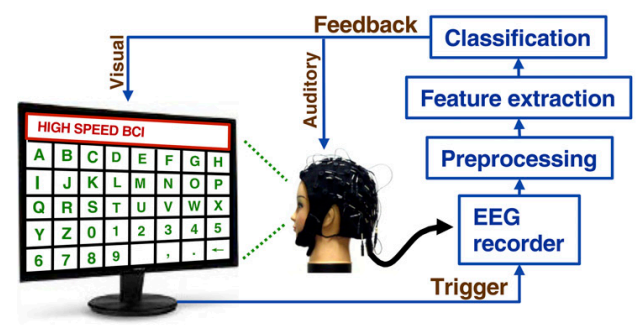October 27, 2015 report
Researchers develop a fast, noninvasive brain-computer interface

(Medical Xpress)—Brain-computer interfaces (BCIs), a longtime staple of science fiction, have slowly been realized over the last 20 years. Researchers have developed neuroprosthetics that, with development, hold promise to compensate for sensory-motor and communication disabilities. Additionally, BCIs suggest new paradigms for computing beyond the physical interface technologies used today.
One of the barriers to realizing practical BCIs is low communication rates. Currently, the most popular method of establishing a BCI is via electroencephalogram (EEG) technology, due to its noninvasiveness and low cost. Unfortunately, due to the low signal-to-noise ratio of EEG signals, the information transfer rate is limited to ~1.0 bits per second. One popular application for such technology is in speller systems developed for people who cannot communicate, in which a user visually targets a letter that is read out by a computer. In some systems, the information transfer rate is as slow as five letters per minute.
Invasive systems involving surgically implanted prosthetics have resulted in faster information transfer rates in both animal and human models, but are considered less practical for obvious reasons. Now, a collaborative of researchers at Bejing's Tsinghua University and the University of California have reported in the Proceedings of the National Academy of Sciences on the successful implementation of a noninvasive brain-computer interface with the fastest information transfer rate ever achieved.
The researchers based their system on steady-state visual evoked potentials (SSVEPs). An SSVEP speller system detects the user's gaze direction to a target character, essentially a keyboard operated by shifting eye direction rather than manual operation. Existing systems using SSVEPs have achieved high information transfer rates, but the upper limits of such systems are still unknown.
The authors hypothesized that the visual latency of single-trial SSVEPs as represented by neuronal population activity over the stimulation time would be very stable across trials. "If this is true, frequency and phase of the stimulation signals can be precisely encoded in single-trial SSVEPs. Much better performance can be expected in the SSVEP speller using a synchronous modulation and demodulation paradigm, which has been widely used in telecommunications," they write. To improve the system further, the researchers adopted a user-specific decoding algorithm that would adjust to individual differences in visual latency.
Another problem addressed by the system is the difficulty of measuring visual latency caused interference from noisy EEG signals. The researchers implemented a new visual latency estimation approach in order to compensate. In online spelling performance among test subjects, the mean spelling rate was around 50 to 60 characters per minute, with an information transfer rate of around 4.5 to 5.5 bits per second, a vast improvement over existing noninvasive BCI spelling systems.
The researchers note that further study is needed to establish systems capable of high work loads, and to determine the stability of visual latency over long periods.
More information: "High-speed spelling with a noninvasive brain–computer interface." PNAS 2015 ; published ahead of print October 19, 2015, DOI: 10.1073/pnas.1508080112
Abstract
The past 20 years have witnessed unprecedented progress in brain–computer interfaces (BCIs). However, low communication rates remain key obstacles to BCI-based communication in humans. This study presents an electroencephalogram-based BCI speller that can achieve information transfer rates (ITRs) up to 5.32 bits per second, the highest ITRs reported in BCI spellers using either noninvasive or invasive methods. Based on extremely high consistency of frequency and phase observed between visual flickering signals and the elicited single-trial steady-state visual evoked potentials, this study developed a synchronous modulation and demodulation paradigm to implement the speller. Specifically, this study proposed a new joint frequency-phase modulation method to tag 40 characters with 0.5-s-long flickering signals and developed a user-specific target identification algorithm using individual calibration data. The speller achieved high ITRs in online spelling tasks. This study demonstrates that BCIs can provide a truly naturalistic high-speed communication channel using noninvasively recorded brain activities.
© 2015 Medical Xpress


















